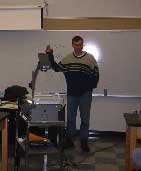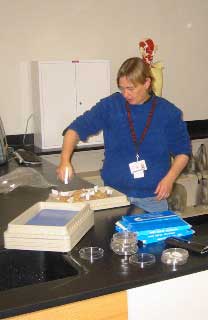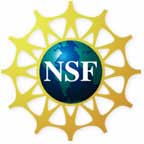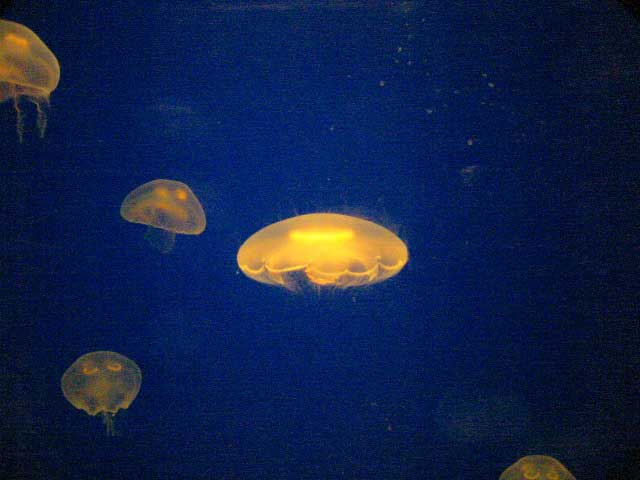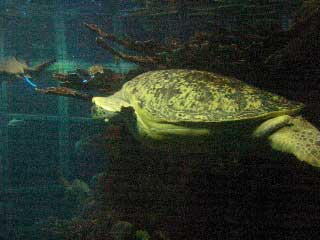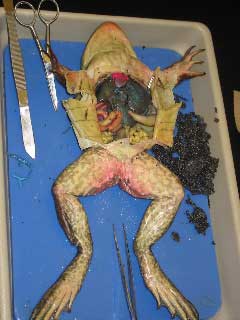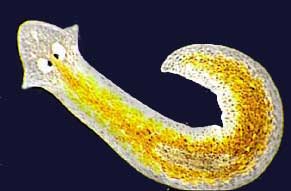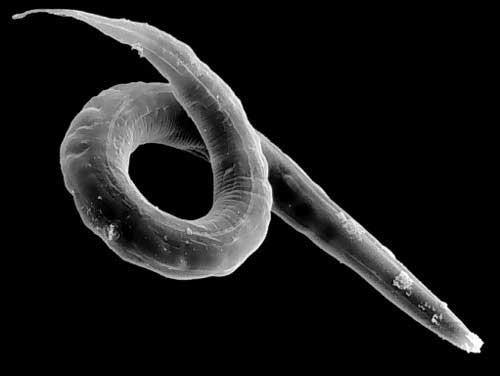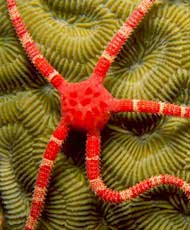Lesson Title
|
Description
|
General Biology
|
|
"Biology is the
Bomb"
|
A presentation that introduces the concept of the
black box in science, and how the scientific method is used to look into
the black box. Includes a discussion of how the opening of various
black boxes in science has resulted in dramatic changes to our world. (Powerpoint
webpage).
|
Black Box Lesson
|
A lesson to accompany the above presentation. Students
are given actual "black boxes" to which they must apply the scientific method
of observation, prediction and experimentation to find out what is inside.
(Word document)
|
Introduction
to Phylogenetics
|
A presentation that introduces phylogenetics: the
science of inferring the history of species, organisms or genes for use
in classification, population biology, or comparative evolutionary biology.
The importance of understanding history is emphasized through analogy
to gangster rap. (Powerpoint webpage)
|
How to make a cladogram
|
An accompanying lesson which teaches students to
make a cladogram (hypothetical species history) from a matrix of shared characters
and a simple Venn diagram. Adapted from
ENSI web
. (Word)
|
Chemistry of Living
Cells
|
A lesson that I presented to Pam's regular biology
class. It is an introduction to the basic types of chemical bonds,
and the four major classes of organic molecules. (Powerpoint webpage)
|
Protist Lab
|
A set of questions to accompany a lab in which students
observe Amoeba, Paramecium and Euglena. The questions
help to steer the students thinking toward the relationship of protists
to multicellular animals. (Word)
|
Kingdom Quest
|
I was fortunate to be able to teach a few lessons
from the Microcosmos curriculum, kindly provided by Dr. Doug Zook. This
link goes outside this page to the Kingdom Quest lesson plan which introduces
students to the challenge and reward of the classification of organisms,
as well as to the five major kingdoms of life.
|
Geologic Timeline
|
An excellent activity from the Microcosmos curriculum
that introduces students to the vast expanse of time over which life has
evolved. The link goes to a .pdf on an external site (at UC Davis).
|
New England Aquarium Activity
Sheet
|
This is an activity sheet for our field trip to the
New England Aquarium. Included are thought questions for each major
section of the aquarium, as well as an invertebrate scavenger hunt. (One
of our teams found 73 different invertebrate species! Can you beat
that?)
|
Phylum Porifera
|
Sponges
|
Phylum Cnidaria
|
Jellyfish, Corals, Anenomes, Hydra
|
Phylum Platyhelminthes
|
Flatworms, Flukes, Tapeworms
|
Flatworms
|
A general introduction to three of the four classes
of flatworms. Includes a discussion of parasitism vs. predation. (Powerpoint
webpage)
|
Research paper assignment
|
An assignment for the students to create a two-page
research paper on a species from this phylum. This is an example of
similar assignments that were made for each phylum. (Word)
|
Phylum Mollusca
|
Snails, Squid, Octopus, Chitons, Tusk Shells etc.
- Unfortunately I seem to have misplaced my presentation on molluscs.
|
Squid Dissection
|
The dissection of a squid is particularly easy and
engaging for students as it only requires one cut, and all of the organs
are easily observable. Most of our dissections were taken from textbooks
or the web, but I developed this one myself (starting from several resources
that are cited within the lab). I felt it went very well, and presented
it at the GK-12 regional meeting.
|
Phylum Annelida
|
Earthworms, Leeches, Polychaetes
|
Segmented Worms
|
A presentation (designed for overheads) about the
three major classes of Annelids. (Word)
|
Phylum Nematoda
|
Roundworms - including the biomedically famous
C. elegans
|
Lab - C. elegans
|
A lesson plan and worksheet for a laboratory dealing
with C. elegans. It introduces the concept of a model system in biology,
and allows the students to observe and speculate on the nature of mutations.
|
Phylum Arthropoda
|
By far the largest and most diverse animal phylum:
Insects, Millipedes, Crustaceans, Spiders and Scorpions. Pam taught most
of this group while I was on Winter vacation :-(
|
Termite Behavior
|
This lab is a very effective way to introduce the
scientific method, or to follow up the black-box lab above. Eastern
termites (Reticulotermes flavipes) will actually follow the trail of
a papermate pen, the ink of which contains chemicals that mimic its trail
pherhomones. It never fails to engage students in a quest to discover
why they follow some pen lines but not others. This lesson inspired
a first-place winning science fair project on termite wood preferences. The
link goes to a .pdf lesson plan prepared by fellow STAMP fellow Nishant Shah.
|
Phylum Echinodermata
|
Seastars, Brittlestars, Sea Urchins, Sea Cucumbers,
Sea Lilies
|
Spiny-Skinned Animals
|
An introduction to the echinoderms. (Powerpoint
webpage)
|
Phylum Chordata
|
Our home phylum. Includes Fish, Amphibians, Reptiles,
Birds, and Mammals. Pictured is Rosalind Franklin - first person to take
a "picture" of DNA
|
Reptiles
|
A presentation about reptiles stressing their relationship
to birds and mammals, and the importance of the amniotic sac to life on
land. Also a brief reference to geologic time. (Powerpoint webpage)
|
Mammals
|
An introduction to the mammals. It emphasizes
important mammalian characters such as warm-bloodedness, milk production,
upright stance, fur, and the placenta. (Powerpoint webpage)
|
